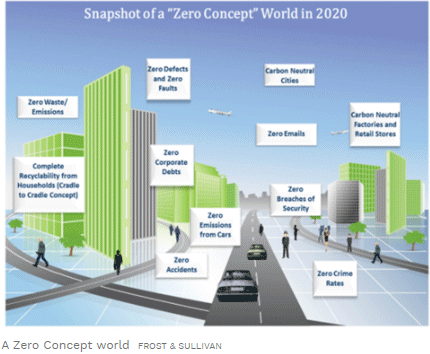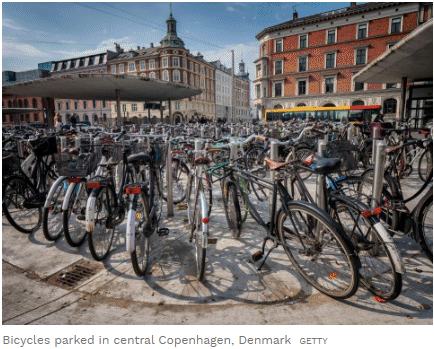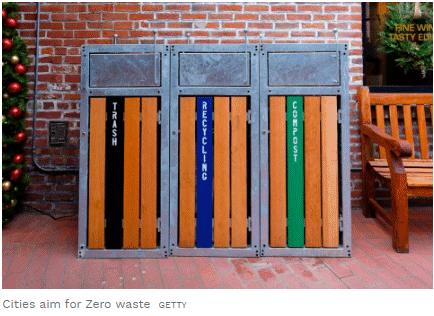By Sarwant Singh, Managing Partner, Frost & Sullivan; Head of Mobility & Visionary Innovation Group
In 2010, Bill Gates first came up with the term “Innovating to Zero” to advocate a nuclear energy technology that would be safe, reliable and have Zero emissions. It’s an idea that stayed with me ever since and, together with the Visionary Innovation Group at Frost & Sullivan, I set out to explore a Zero Concept World, where the vision of “Innovating to Zero” could be used to guide and achieve Zero emission vehicles, Zero waste, Zero accidents, Zero defects, Zero security breaches, Zero carbon emissions (carbon neutral buildings and cities), Zero obesity, and even Zero diseases.

I am not under the illusion that this utopia is likely to happen (unless it’s a Bollywood movie) anytime soon or, for that matter, ever. And, indeed, my interest lies not so much in the destination—a world free of errors, defects and negatives—as in the journey and the gains that I believe will be made along the way. I know that if we, as a society, are able to accomplish even a fraction of our ultimate goals, it will mean real progress.
What is encouraging is that, in the course of my research, I’ve come across numerous instances of people, cities, companies and governments consciously moving towards this idea of “Innovating to Zero.”
Our Cities
The perils of climate change are starker than ever before. Earlier this month, New Zealand’s ‘Zero carbon’ target was signed into law, setting the country on the path to reducing carbon emissions to net zero by 2050 – maybe a bit too slow and long. Several cities, in the meantime, have committed to becoming carbon neutral—where the net carbon emissions generated annually by a city is absolutely Zero—with Copenhagen leading the charge.

The Danish capital’s march towards becoming the world’s first net carbon-neutral city by 2025 is well on track and what has truly impressed me is the way in which sustainable practices and improved quality of life measures have been successfully welded with economic growth. The idea that the future will bring with it a revolutionary brand of innovative ‘green’ growth with exciting new opportunities for businesses represents a model that every city, grappling with mounting challenges, should aspire to emulate.
Carbon neutral buildings—which operate using intelligent systems and renewable energy, and are off-the-grid or harvest energy onsite—will play an important role in a city’s drive towards becoming Zero carbon. In 2018, the Mayors of 19 leading global cities including London, Paris, New York, Johannesburg, Sydney and Tokyo signed the Net Zero Carbon Buildings Declaration, pledging that all new buildings in their cities would function at net zero carbon by 2030.

In the meantime, cities are also pushing towards Zero waste which envisions a cradle to cradle ideal of complete recyclability. San Francisco which has fallen short of becoming a Zero waste city by 2020 has, nevertheless, made massive progress in terms of recycling, composting, or reusing almost 80% of its waste.
Our Transport
The automotive industry has long been familiar with the concept, using it both as a tool of competitive differentiation and to tackle what I call the three evils of the industry: congestion, air pollution and road fatalities. The “Innovating to Zero” solutions on which they have zeroed (!) in are electric cars and autonomous vehicles.
From the early pathbreakers Toyota (with its hybrid, Prius) and Nissan (with its insanely popular, Leaf), electric vehicles with zero emissions have rapidly gone mainstream. Today, almost every leading automaker, including the flagbearer of all things innovative –Tesla – has worked to create efficient and environmentally-friendly e-mobility alternatives.

If electric cars speak to the issue of Zero vehicle emissions, then autonomous vehicles have been put forth as the solution for a world with Zero accidents. Volvo and Mercedes’ holistic vision of Zero car accidents yokes together technology developers, infrastructure planners, and government & policy makers to enhance vehicle, road and driver safety. The ‘Vision Zero’ strategy of Continental Automotive Systems, a leading automotive systems supplier, is powered by passive and active vehicle safety technologies that preempt accidents before they can happen. Over two decades ago, Sweden initiated a pioneering ‘Vision Zero’ project which seeks to systematically eliminate serious injuries or deaths caused by traffic accidents, eventually reaching Zero fatalities by 2050. Variants of Sweden’s ‘Vision Zero’ have been implemented in cities throughout North America and Europe with positive results.
Our Industries
In the retail sector, I foresee tremendous potential for Zero carbon shops and Zero carbon products (à la Marks & Spencers’ famous carbon neutral bra). I’m quite certain there’s soon going to be Zero design-to-shelves response time where data analysis and customer feedback will be used to continuously create and market designs that are always current – the logical conclusion to Zara’s extremely agile and responsive business model. Zero shrinkage would imply the absence of inventory losses caused by shoplifting, employee theft, administrative error or vendor fraud. While these are all to the good, one “Innovating to Zero” concept that I am sure is likely to face a chill reception is: Zero discounts!
Today, sustainability, and not just profits, is a core business objective. Italian luxury fashion company Gucci recently articulated its goal of becoming an entirely carbon neutral company, while German industrial manufacturing giant Siemens is already working towards becoming the world’s first major industrial company to achieve a net-zero carbon footprint by 2030.
Apart from carbon neutral factories, the manufacturing sector has embraced the grail of Zero defects. This “Innovating to Zero” concept has morphed from a theoretical concept into a quality improvement mechanism and now onto to its current incarnation as a full-fledged business and manufacturing strategy. The Six Sigma strategy—whose extremely strict quality control standards are touted to result in an astounding 99.99966% defect-free products—is a variant of this theme.
Our Work
“Innovating to Zero” could have many avatars here—Zero papers (paperless office) and now even Zero emails, Zero downtime, Zero delays in delivery, Zero client complaints, Zero waiting time, Zero contract hours, Zero work accidents, Zero latency, and Zero business incubation period—that could result in safer, more flexible and efficient work environments.
Quite frankly, an office with paper has become passé (I’ll make an exception for publishing firms!). For that matter, emails are on their way to becoming redundant. In my own case, I find I am increasingly using new communications apps like WhatsApp and Telegram, nudging my email account towards redundancy, even as I actively contemplate new payment getaways like blockchain that promise greater security than traditional emails.

There’s Zero latency, which will eliminate the time lag between the receipt of, and response to, critical information. Go-to-market pressures will alleviated by advanced technology that will enable ideas to be created, implemented, and commercialized in Zero time, leading to Zero Time Business Incubation (ZTBI).
To this list I am now going to add a few “Innovating to Zero” ideas that Frost & Sullivan’s CEO Darrell Huntsmann often talks about: Zero Friction Capital—finding capital and optimizing its use; Zero Friction Career—streamlining the movement of human capital between and within organizations so that their skills are optimally matched to current organizational needs; and Zero Friction Education—creating a fluid system of work and education which allows people to move organically between both spheres, while maximizing results at both professional and personal levels.
Our Health
The scope for “Innovating to Zero” in the healthcare sector is enormous. For instance, Net Zero Hospitals could guide the construction of hospitals in terms of ensuring greater energy efficiency, while achieving the actual functions of the hospital—Zero medical waste and net Zero surgery errors—likely to be more long-term ambitions.

Minimally invasive surgery could give way to Zero invasive surgery, while the march towards Zero diseases has already yielded gains in the form of reduced malaria related deaths and eradication of polio in large parts of the world.
Zero hunger or Zero malnutrition is a long-term global aspiration. In India, Britannia Industries’ Tiger brand of iron fortified biscuits aimed to realize Zero child malnutrition. Zero obesity is likely to be the next big target and I foresee a carrot and stick approach to achieving it. The carrot will be incentives in the form of perhaps gym memberships or lower insurance premiums for those who are healthy, while the stick approach will manifest in increased taxes on fatty foods—the so-called Fat Tax. That said, companies and consumers are both conscious of the perils of an expanded waistline, explaining the popularity of Zero calorie foods and Zero sugar drinks like Coke Zero and Pepsi Zero Sugar.
Beyond Zero
Tremendous investments of time, money, and human intelligence will be put into the service of “Innovating to Zero”, despite the full knowledge that many of the goals will not be achieved in their entirety. But what will be exciting will the journey towards this Mega Vision, with all its attendant opportunities to truly transform our world. Indeed, “Innovating to Zero” is already reinforcing positive changes to cultures, mindsets and ecosystems – it’s unlikely that Copenhagen’s push towards sustainability would have been able to maintain its momentum were it not for 40% of the city’s residents opting to forgo cars for bicycles. It also reflects changing goal posts for humanity: from economics, trade and profits to innovation-driven agendas that aim to create a better world.
I was once asked about what would be next: a world of “Beyond Zero” where, for instance, buildings and cities would not just be carbon neutral but carbon positive? That’s an idea well worth considering once we realize innovations that are truly Zero.
Article was originally published on Forbes.com



